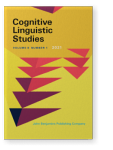Vol. 8:1 (2021) ► pp.152–174
Making meaning with metaphor in grief therapy
A single-session segmental approach
Metaphors play an important role in contemporary approaches to grief therapy by helping clients (re)construe their continuing relationship with the deceased. Relevant studies have illustrated the substantive elements of metaphors (i.e. sources, targets, and mappings) in this regard, often focusing on localized bursts of intense metaphoric activity. This paper highlights the extended nature of metaphoric conceptualizations and their relationship with key meaning-making processes, following the principle of ‘correspondent analysis’ as a collaborative move between language analysts and therapy practitioners. Three specific phenomena are detailed through a mixed methods analysis of 18 motivated segments in a single session of grief therapy: (i) sporadic sources, (ii) persistent sources, and (iii) metaphor ‘chaining’ across embodied and verbal activity. Their respective links to treatment objectives and processes demonstrate how metaphor theoretic constructs dovetail with therapeutic work, and suggest future avenues for modeling unfolding metaphoric activity as a time series.
Article outline
- 1.Introduction
- 2.Data and methodology
- 3.Results and discussion
- 3.1Sporadic substantive source categories
- 3.2Persistent image-schematic source categories
- 3.3Metaphor ‘chaining’ across embodied and verbal activity
- 4.Conclusion
-
References
